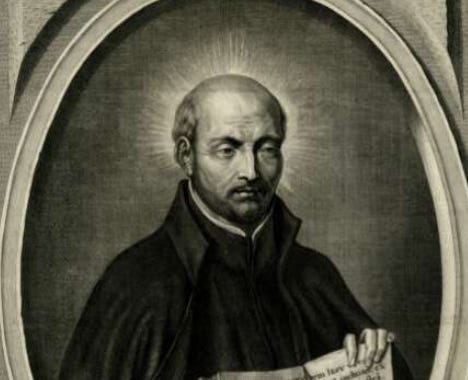July 31 is the feast of St. Ignatius of Loyola, the priest, missionary, and mystic, who lived five centuries ago, founded the Jesuits — the Society of Jesus — and introduced a form of Christian spirituality that has formed great saints, from all walks of life, ever since.
To celebrate the St. Ignatius’ feast, The Pillar brings you a St. Ignatius reading — and watching — list.
As Ignatius himself used to say: Ad majorem dei gloriam.
Born in 1491 in the Basque region of northern Spain, Ignatius left home at 16 to serve in as a page in a royal household, and eventually became a soldier.
In May 1521 —500 years ago this year — Ignatius’ leg was shattered by a cannonball in the Battle of Pamplona. He survived, but spent an entire year in bed recovering.
With very little to read during his recovery, Ignatius read a book about the life of Jesus Christ, and stories of the saints. He had a conversion reading those stories, and decided he wanted to spend his life serving God, and becoming a great saint.
The next year, after an all-night prayer vigil, he began living in a cave and reading Scripture. Eventually, he felt called to become a priest. To do so, he had to start studying Latin with children, even though he was more than 30 years old. With companions, he founded the Society of Jesus in 1534, and was ordained a priest in 1538.
He led the Jesuits until his death, July 31, 1556.
How a cannonball changed “the course of the world”
In Pamplona, five hundred years ago, all Ignatius’ worldly dreams were shattered in an instant. The cannonball that wounded him changed the course of his life, and the course of the world. Seemingly small things can be important. That cannonball also meant that Ignatius failed in the dreams he had for his life. But God had a bigger dream for him. God’s dream for Ignatius was not about Ignatius. It was about helping souls. It was a dream of redemption, a dream of going out into the world, accompanied by Jesus, humble and poor.
Conversion is a daily occurrence. Rarely is it once and for all. Ignatius’ conversion began in Pamplona, but it did not end there. He converted throughout his life, day after day. And this means that throughout his life he put Christ at the center. And he did this through discernment. Discernment does not consist in always succeeding from the beginning, but in navigating and having a compass in order to be able to set out on the path, which has many twists and turns, but always allowing oneself to be guided by the Holy Spirit, who leads us to the encounter with the Lord.
-Pope Francis, on the conversion of St. Ignatius
Who’s buried in St. Ignatius’ tomb?
St. Ignatius is entombed in an extraordinary Baroque altar at the Church of the Gesù in Rome, the home church of the worldwide Society of Jesus.
Every day at 5:30 in the afternoon, a painting in the tomb is lowered by a system of ropes and pulleys, to reveal a statue of Ignatius himself.
It’s pretty cool. Check it out:
Suscipe, Domine
Perhaps the most well-known prayer of St. Ignatius is the Suscipe, which many Catholics pray after receiving Holy Communion.
Take, Lord, and receive all my liberty, my memory, my understanding, and my entire will, all that I have and possess. Thou hast given all to me. To Thee, O Lord, I return it. All is Thine, dispose of it wholly according to Thy will. Give me Thy love and Thy grace, for this is sufficient for me.
The late Jesuit priest Fr. John Hardon offered a commentary on the prayer and its meaning.
“It is one thing to tell God, Lord, I’m giving You everything, it is something else to close the Suscipe by telling God, ‘all I want from You is Your love and Your grace, having but these I am rich enough and ask for nothing more’.
In all of our lives, God will both deprive us of things we had, remove from our lives precious possessions, persons, objects we’ve enjoyed. God may send us the last thing on earth, if we had our choice, we would choose. But if we are really, really, I’ll read once more, really in love with God, then all we want from Him is His love, which we cannot see and His grace which we can’t experience.”
Where he lived and died
Where did St. Ignatius actually live? Well, check it out:
The soldier saint
Before his conversion, St. Ignatius was a skilled military leader. After his conversion, he continued to use military metaphors and language to describe his mission and identity as a Catholics.
The saint was also an accomplished fencer. So to celebrate that, here’s the Tokyo Olympics women’s épée gold medal bout:
And here’s the men’s gold medal sabre match:
Anima Christi
St. Ignatius of Loyola didn’t compose the Anima Christi prayer, but it was a favorite of his, and is perhaps especially appropriate for his feast:
Soul of Christ, sanctify me.
Body of Christ, save me.
Blood of Christ, inebriate me.
Water from the side of Christ, wash me.
Passion of Christ, strengthen me.
O Good Jesus, hear me.
Within your wounds hide me.
Permit me not to be separated from you.
From the wicked foe, defend me.
At the hour of my death, call me
and bid me come to you
That with your saints I may praise you
For ever and ever. Amen.




